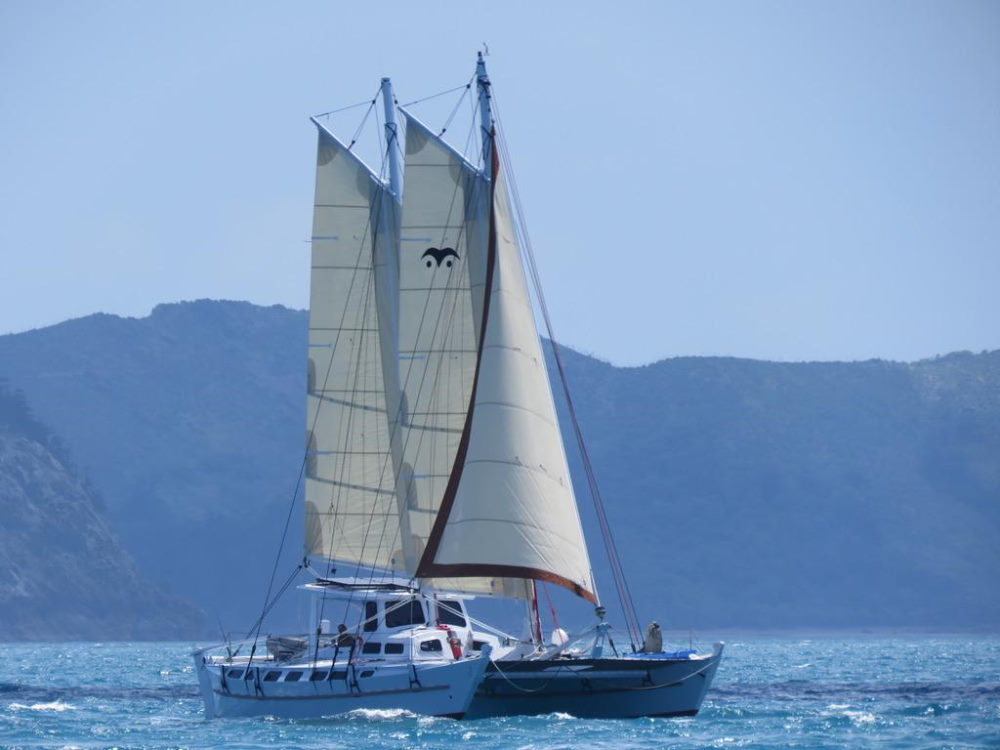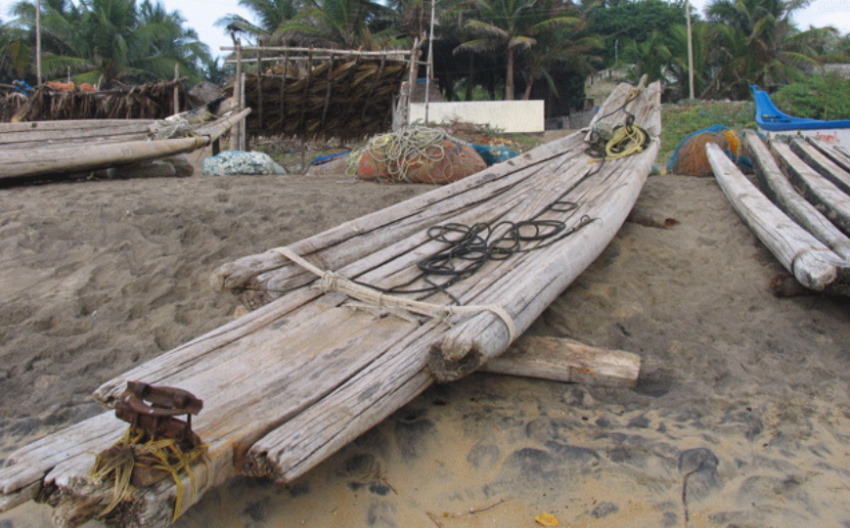Catamarans
A Definition
Catamarans are vessels (power or sail) with two parallel hulls of equal size. A catamaran gets its stability from a wide beam (some cats like Looping and the old Lagoons accentuate this).
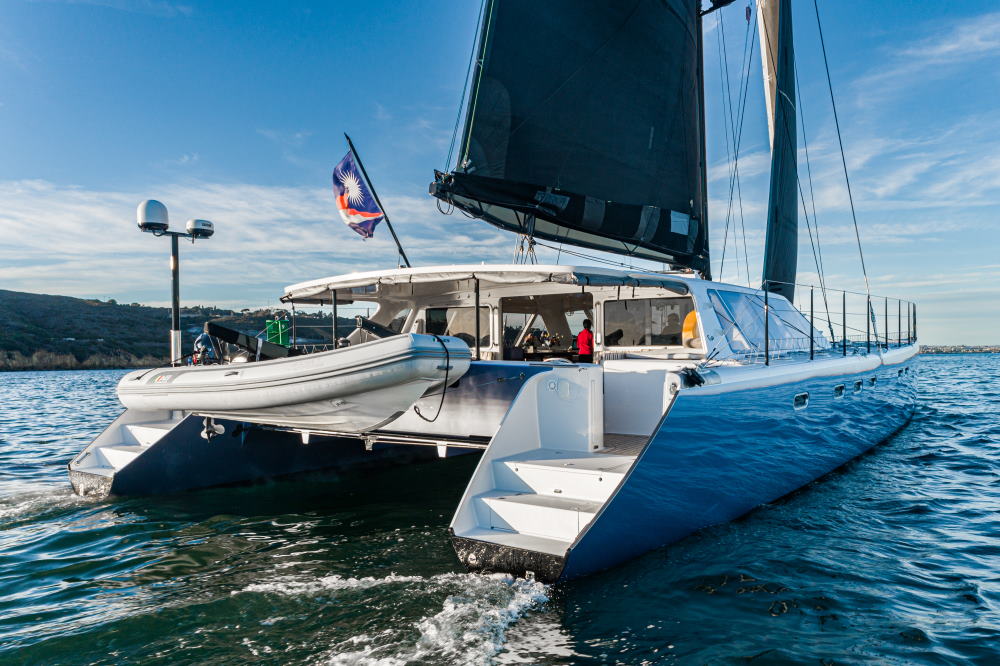
In general, the ratio of length to beam is around 2:1. Some yachts are more narrow (e.g. the Outremer 51) and some are wider (such as the Nautitech 40). On katamarans.com, we focus on sailing cats.
Different to Monohulls
This is different from a monohull which gets stability from a ballasted keel. Catamarans typically have less volume in the hulls, a lower displacement and a shallower draft than monohulls of a similar length. The hulls slip through the water faster (less resistance), and a broader platform means that heeling and pitching are reduced. Less energy is lost generating a wake.
The Polynesians built the first multihulls.
At the bottom of the page, you will find a list of catamarans that we have reviewed on Katamarans.com. Browse by page, or filter the results using the search tool provided.
Where we have specific information on individual boat manufacturers, we will list them here.
Multihull Manufacturers
An A-Z of Builders
Atlantic Catamarans
Chris White Chris specialises in the design of high-performance cruising catamarans and trimarans. Examples include the Atlantic 57, the 47 and the 72. Chris White has developed some innovative designs such as the MastFoil rig – effectively 2 genoas for ease of handling.
Aventura
Cruising cats that are built in Tunisia. The range includes a 37 and a 45-footer.
Balance Catamarans
A successful South African brand that manufactures the 526, the 482, the 442 and others. There’s a long waiting list if you order one of these boats! These blue water cruising yachts have been designed to be fast, safe and can be sailed shorthanded. They are simple to maintain, carry a decent payload and are comfortable to sail and live aboard. It’s proving to be a popular combination.
Bali
Launched by the Catana Group in 2014, Bali has become one of the most successful manufacturers of cruising cats in the charter and owner markets. They are known for innovative features like the aft pivoting “garage” door, solid foredecks and wide open living spaces. And big fridges. The Catsmart, the baby of the range at 38-foot and twin aft helms, was launched in 2023.
Catana
Historically one of our favourite performance cruising catamaran manufacturers, they now focus more on their Bali brand. This company launched the Catana 471 back in the day, and its latest model is the 50-foot Ocean Class.
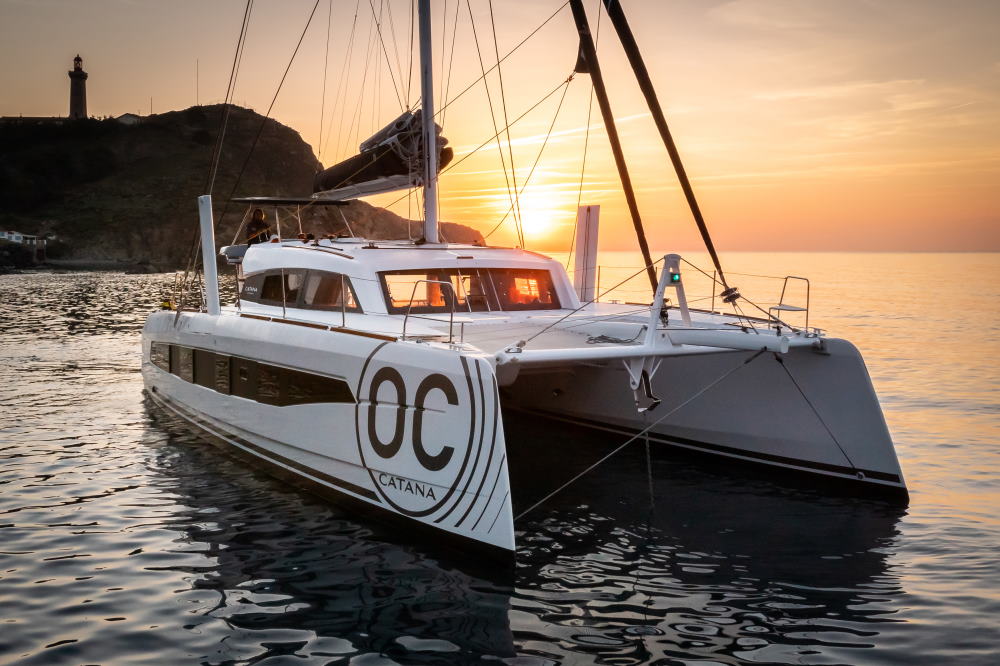
Dazcat
A UK-based performance manufacturer with many Fastnets under their belt. Along with Marsaudon, Dazcat produces some of the fastest-performance cruising catamarans on the market. They are now moving into the performance cruising market with their Ocean Cruiser 55 – a stunning design with a forward helm and two raised twin aft helms.
Excess
Part of the Beneteau Group, Excess began building sportier designs than sister company Lagoon with lower booms and aft helms. They are targeting a similar market to Nautitech. They first launched the 12 and 15 in 2019 with adapted Lagoon molds. The newer models, the 11 (2020) and 14 (2022) are 100% Excess Designed.
Fountaine Pajot
This French yard has been building catamarans since the launch of the Louisiane 37 in 1983 and is one of the most successful manufacturers in the market. They have evolved their designs over time using customer feedback and the latest technologies. Fountaine Pajot is leading the production yard development of eco-powered yachts with the Aura 51.
Gemini
The Gemini Legacy 35 has been built in the US since 1981 (now Annapolis): a family-friendly cruising catamaran that continues to be popular. Over 1,100 have been launched. She is famous for her narrow beam, decent sailing performance and shallow draft. LOA 35’4″, LWL 33′, Beam 14′.
Grainger Designs
Highly regarded designer of performance catamarans including the Raku Sailing range, from 32′ to 66′ LOA for fast efficient construction from Panel Kits.
Gunboat
From Peter Johnstone to Grand Large Yachting, Gunboat is surely the biggest catamaran brand out there and a Gunboat 68 is on many people’s wish lists while they are filling out their lotto numbers. With Grand Large, they are going large with the launch of the Gunboat 80. They have also launched a 72′ flybridge cat and will be producing a Gunboat 70.
HH
The 66, the 55, the 50, the 44 and now the 52. These luxury yachts, manufactured to a high standard, are snapping at Gunboat’s heels. The range goes from the HH44 to the HH88.
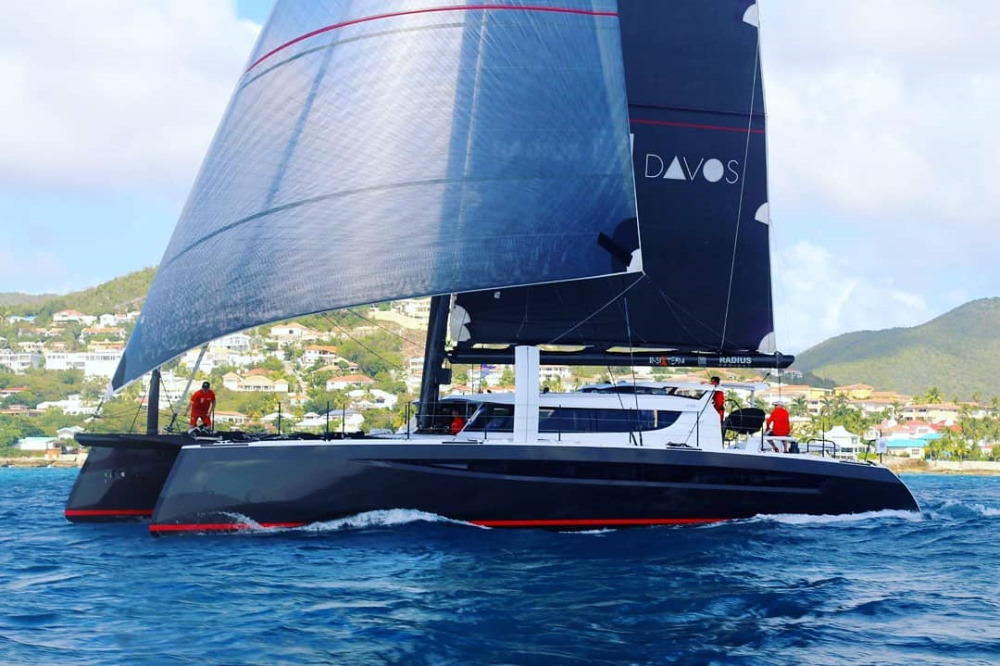
ITACatamarans
An Italian performance yard who have launched some great designs including the 14.99 (Yacht Design Collective) and the 15.49.
Kinetic
Kinetic is building two luxury performance models: the 62 and the 54. Kinetic is a niche manufacturer from South Africa who is gaining a good reputation for product quality.
Knysna Yacht Company
Another excellent boutique South African manufacturer who are most famous for the Knysna 500 SE.
Lagoon
The market leader in catamaran production; they control over 30% of the market. They also compete with Sunreef in the luxury market working closely with VPLP.
Leopard
Born from their charter partnership with The Moorings, Leopard is now one of the largest cruising catamaran manufacturers. Strong, sturdy cruisers from South Africa.
Lightwave Yachts
Australian manufacturer of the Lightwave 46.
Marsaudon Composites
Marsaudon is about speed with no compromise from the L’Orient yard. This range of French performance cats, from the 42 to the 57, is now marketed under the ORC brand (Ocean Rider Catamarans). The latest design was developed by Marc Lombard. In 2023 they ran into financial difficulties. Let’s hope they find a buyer.
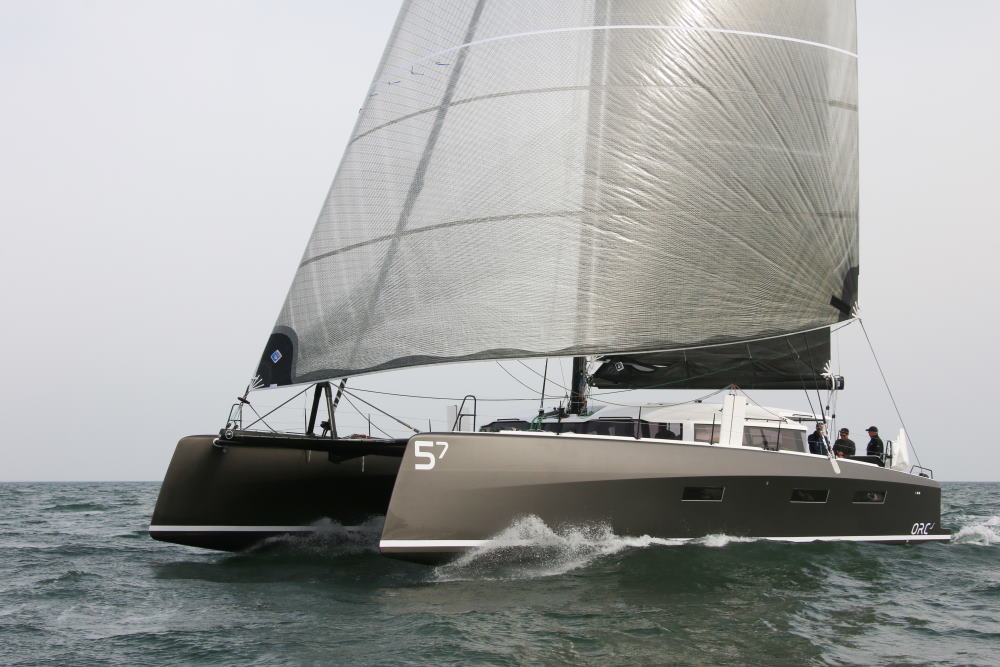
McConaghy
Manufacturers of luxurious multihulls from the McConaghy 55 to the 100.
Moon Yachts
Polish luxury builder who has launched the Moon Yacht 60 (Sail & Power)
Nautitech
The Nautitech range has an excellent blend of performance and comfort. They build a 40, a 44 and a 46, soon to be replaced by a 48-footer.
Ocean Explorer
Luxury performance yachts built in Finland and designed by Germán Frers.
Outremer
Fast cruising cats, these boats have been designed to travel long distances quickly and safely. The Outremer 51 is their most successful model but the 52, designed by VPLP is replacing that. The 45 is also popular thanks to “Sailing La Vagabonde”. The 55 is also selling like hotcakes.
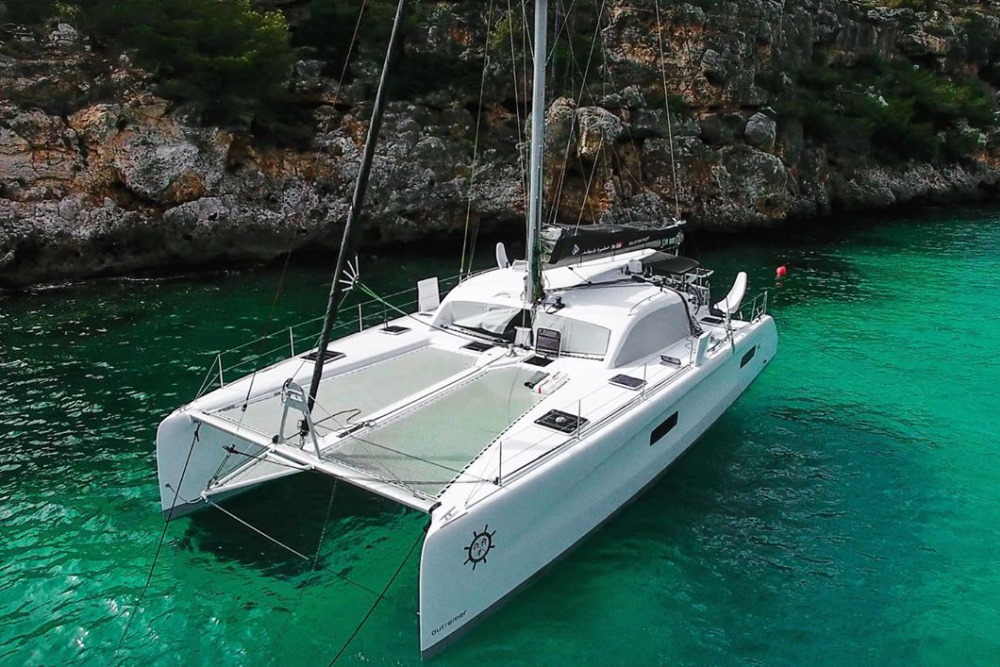
O-Yachts
Designed by Eric Lerouge and Dan Levy and built in Latvia, O-Yachts is a boutique shipyard building high-quality performance cruisers like the Class 6 and Class 4. The Class 6 is famous for its “Spine”.
Privilege
A French luxury cruising catamaran manufacturer with a long history in the industry. Marc Lombard is an established partner in the design of this brand. Their closest competitor is probably Sunreef, but Privilege would argue that their yachts are better designed for long passages. If you want to circumnavigate without compromising on comfort, this is your yacht.
Prout
The UK brand that arguably invented the cruising catamaran market, Prout went bust in the early noughties, but their yachts live on. The Snowgoose 37, Prout 45, Quest 33 and Event 34 are all popular designs. They are not the fastest (especially upwind), but they are solid, safe and sturdy cats.
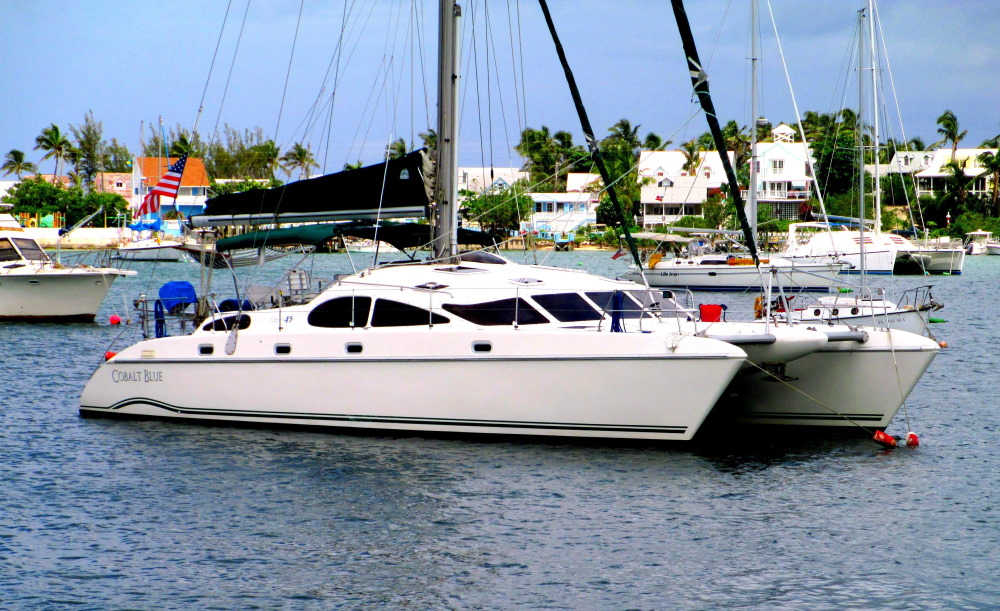
Seawind
Cruising cats that sail, Seawinds are now produced in their factory in Vietnam. The range includes the popular 1260, 1600 and 1370 which have proven very popular with buyers.
Schionning Designs
Schionning offers kits and advice to help you build your dream catamaran. Schionning owners either self-build or hand the design over to an affiliated shipyard such as Noosa Marine. These are highly customised performance catamarans such as the Arrow and G-Force Series. They are now based in Cape Town, South Africa.
Slyder
A small German manufacturer who specialises in electric powered yachts.
Sunreef
The market-leading luxury catamaran brand. Sunreef Yachts seem to be getting bigger and bigger, and they are investing heavily in Solar Power. It’s sunny in Dubai!
Vision Yachts
Another impressive South African Yard that builds the elegant Vision 444, a blue water sailing catamaran that’s strong, sails efficiently, is spacious and forgiving: an all-round yacht pitched at the likes of Nautitech with a high level of finish and attention to detail.
Wharram Designs
The classics. Unique self-build boat plans inspired by the canoes of the Polynesians.
Windelo
Probably the market leader in eco-cats. Windelo takes a no-compromise approach to building their sustainable yachts including using innovative materials designed to minimise their carbon footprint. They have developed an impressive electric power management system for the 50 and the 54.
Top 10 – Best Catamarans
What are the ten best multihulls ever produced? This is a hard list to pull together and remember that these are our personal favourites. We could probably debate this all day. So, in no particular order:
Gunboat 48
Gunboat (now owned by Grand Large) doesn’t make sub-50-footers anymore. That’s a shame. Gunboat only made six 48s, they hold their value well.
Nautitech 40 Open
We are biased here as we used to own one, but this 40-footer is a great sailor with lots of living space for the money. The newer 44 is a significant upgrade, but it was the 40 that moved the dial for Nautitech.
Marsaudon ORC 57
Wow factor 10! This is your boat if you want to sail fast and in comfort.
Lagoon 380
The Ford Escort of the catamaran world. Or should we say the Peugeot 208? Lagoon was never able to replicate its success in this size. Maybe the Excess 11 will take over?
Outremer 45
It was a close call between the 45 and the 55, but Barreau’s classic design nudges it for us. The 51 is also a great boat. We might switch this to the 52 if we get the chance to test one.
Prout Snowgoose 37
The classic that continues to cross oceans. Here is the catamaran you want to circumnavigate safely on a sub $100k boat. There are two versions, the original and the Elite. The earlier boat is the better sailor if you keep the weight off, but the Elite will soak up more weight.
Leopard 46 (2006)
This Morrelli and Melvin design has aged well. These are solid and seaworthy boats that remain popular on the second-hand market.
Privilege 495 (2004)
Marc Lombard nailed it with the 495. These are also still very popular on the second-hand market.
Catana 471
The high tide mark for Catana, in our opinion, along with the 431. Another great design from Barreau. Plus it’s very pretty.
Balance 526
A very popular South African blue water performance cruiser. There’s a long waiting list for these yachts and for a good reason. If you like a protected helm, the “Versa-Helm is an excellent solution.
Types of Catamaran
At katamarans.com, we group boats as follows:
Performance Catamarans
Yachts that have been designed for speed with safety. Famous examples include the Gunboat 68, the Outremer 55 and the Atlantic 57.
Cruising Catamarans
Yachts designed to maximise the living space while maintaining acceptable performance. Lagoon, Bali, Fountaine Pajot and Leopard dominate the market, but there is plenty of choice with other manufacturers such as Nautitech, (more performance), Excess, Seawind and Aventura.
Luxury Catamarans
The “Mercedes S Classes” of the multihull world. Privilege, Sunreef and the larger Lagoons dominate here. Some of the performance brands are also luxury boats of course: Gunboat, McConaghy, HH and Kinetic are examples.
Classic Catamarans
Designs that have gone down in history as classics, these boats are still sought after today. This section includes Prout, the older Lagoons, Catana and Outremer.
Custom Catamarans
One-off designs and builds, either in the luxury or the racing sectors. for example Hemisphere: the largest catamaran ever built.
Eco Cats
One of the more significant trends in the industry is the development of eco-friendly yachts. You can argue that all sailing cats are eco-friendly as they aim to be powered by the wind (most of the time), but there is much work to do in this area.
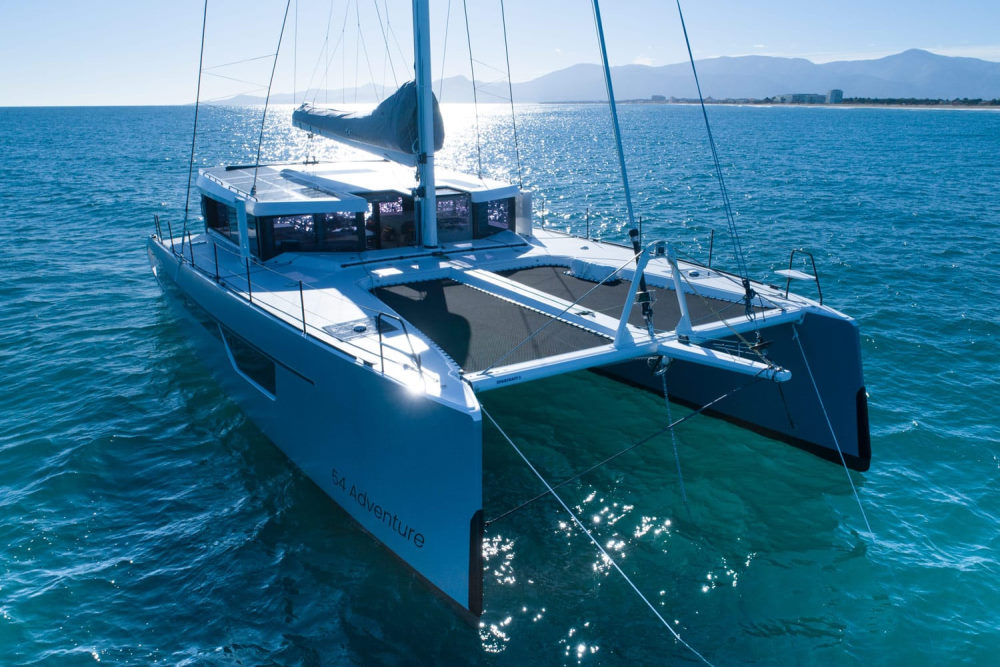
Windelo leads the pack: they design and manufacture light boats that are designed to sail in 4-5 knots of wind, with electric engines for the marina, plenty of solar and hydro-power-generation and they use recyclable materials in the construction.
Other manufacturers who are working hard in this area include HH, Outremer, Excess, Fountaine Pajot and Sunreef.
Pros and Cons of Catamarans versus Monohulls
Catamarans have many advantages over monos. But there are some disadvantages too, of course. You can’t have everything.
Pros
✅ Higher cruising speeds.
Generally speaking, a catamaran will have a higher Sail Area to Displacement ratio than a comparable monohull and will be faster at wider wind angles.
However, fixed keel cruising cats are not as efficient upwind, so your VMG will be lower (Velocity Made Good) going upwind. Dagger-board cats, however, can match or exceed monohull speeds upwind. Performance cats can sail at windspeed and even up to 1.4x TWS in some cases.
✅ More Living Space
Perhaps the biggest advantage. Even performance cats with narrow hulls have a large living platform up in the saloon and cockpit. Monohulls cannot compete here.
✅ Less Heeling
Catamarans do heel, but not to the same extent as monohulls. That means a more comfortable sail for everyone (notably less frequent sailors). Sailing flatter on long passages is less tiring.
✅ More Stable at Anchor.
If you have ever sat on a catamaran anchored in a bay with a swell next to a monohull, this point needs no further explaining.
✅ Quieter Under Power
On night passages, you can cruise on a single engine and keep one of the hulls quieter for whoever is off watch.
✅ Cruising in shallow waters
With a shallower draft, you’ll be able to get into anchorages (in the Bahamas for example) that a monohull can only dream of. This is particularly true of daggerboard cats. With the boards up, your draft will be a metre or less.
✅ Manoeuvrability
Most catamarans have twin engines (though not all). That makes them highly manoeuvrable in tight spots. Most cats can turn 360 degrees within their own length.
✅ The Nets
One of our personal favourites. The trampolines are good for lounging, jumping off the boat, dolphin watching, you name it. Not all catamarans have nets, however.
✅ Sugar Scoops
Getting on and off a catamaran with gear via the sugar scoops is generally easier. That includes diving, swimming and so on. Although modern monohulls with swimming platforms are just as convenient.
Cons
❌ Larger Marina Fees
Most marinas charge extra for catamarans versus the same-length monohulls. That is because they are beamier. The additional cost can be anything between 50-100%
❌ Higher Maintenance Fees.
There are two engines. And two rudders. And more heads. And that all means more maintenance costs. At least you only have one mainsail!
❌ Less Efficient Upwind (Not always)
Most catamarans are happiest on a beam reach or a broad reach. Thanks to their speed through the water, the apparent wind moves forward and sucks your catamaran along: they make their own wind. Close-hauled, most cruising cats do not point as high as a monohull. 55 degrees to true is probably your limit before you start sliding. This is not an issue on performance cats with daggerboards, however. The gap is most noticeable in lighter winds.
❌ Wave Slap
This depends on the catamaran, but some designs (particularly older models with lower bridge deck clearances) suffer from wave slap, especially heading upwind into a chop.
❌ Different Motion
Although catamarans are more stable than monohulls, they do have a different motion underway and one that not everyone likes. With no keel, they tend to pitch more and shorter boats tend to “hobby-horse”, if there is too much weight in the bow and aft.
45 feet seems to be the sweet spot when this becomes less of an issue. Good designs make a point of centralising the weight as much as possible. Dazcat and Outremer are good at this. You’ll notice that performance cats like Outremer and HH have long nets to keep the weight off the bow – this gives a more comfortable ride.
❌ Increased windage
This is especially true of manufacturers like Lagoon and Fountaine Pajot. Sunreef also suffers from this. That’s the trade-off you make for more living space. If you look at some of the earlier Outremer and Catana designs, they look very low-slung compared to modern designs, almost like spaceships. Except there wasn’t much space inside the ship!
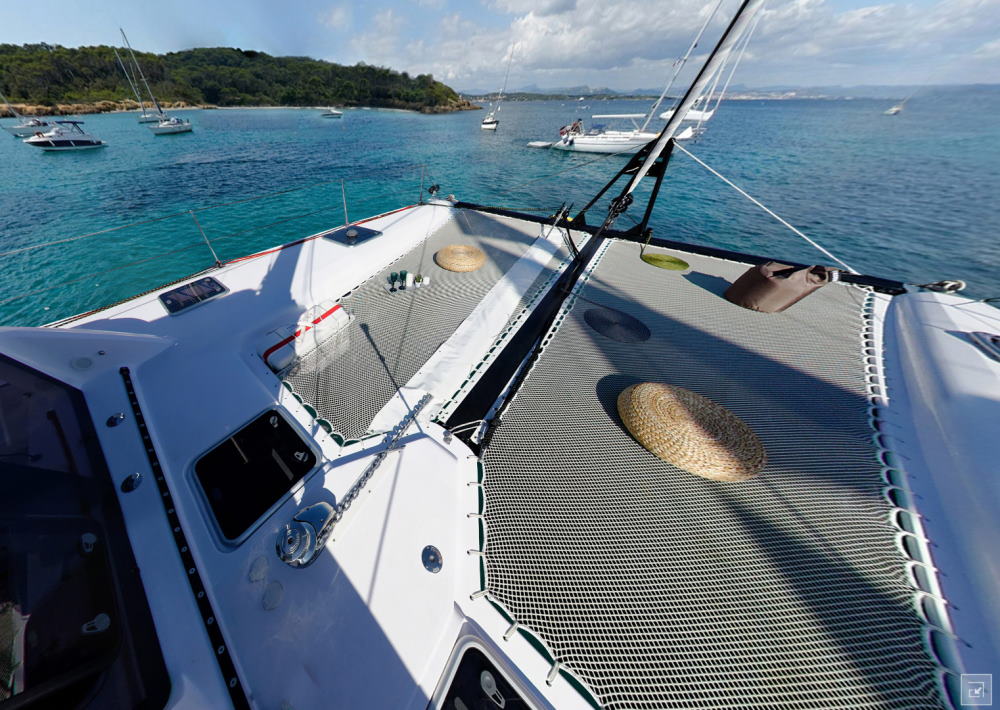
Facts
What is the Fastest ever Catamaran?
Strictly speaking, this would be Sailrocket 2, as it has two hulls (although she flies one most of the time). This speed yacht smashed the 500m world speed sailing record, hitting over 65 knots (75+ MPH) in Namibia in 2012. However, this boat has such a radical design that it’s difficult to pigeonhole her into one category.
A History of Catamarans
So who built the very first catamaran? The Polynesians and Micronesians used double-hulled craft in the 1700s and probably before to travel between the islands. James Cook spotted a number on his travels.
If we are talking about modern catamarans, which are more the focus of katamarans.com, we’d have to say that Californian surfer Hobie Alter can lay a claim, although Hawaiian surfer Woody Brown built an ocean-going catamaran called Manu Kai (“Sea Bird”) with the Hawaiian Alfred Kumalai in the late forties so we should probably give him the medal.
The Wharram Legend
One man who towers above everyone else in this regard is Englishman James Wharram, who was inspired by Polynesian designs and built the first modern catamaran to cross an ocean. His 23’6″ yacht was called Tangaroa, and she made her first Atlantic crossing in 1956. Wharram then improved the design, launched Rongo, and sailed back to England via New York in 1959. “Two Girls, Two Catamarans” is an excellent account of his travels if you want to delve deeper into his story.
And it was UK companies that were at the forefront of the production multihull industry in the early days, notably with Prout. Their main competitor was a builder called Sailcraft (run by Reg White), who built the Iroquois 30 and 30 Mk II, and the Cherokee 35.
Catalac, another UK builder, was also building cruising catamarans from 8 to 12m at this time, and there were smaller yards building yachts such as the Heavenly Twins 26 and the Hirondelle 23. Tony Smith built trimarans called Telstars and later moved to the States, where he started Gemini.
France
Of course, no history of 2 hull boats is complete without a mention of the French builders who now dominate the industry. A robust ecosystem developed along the Atlantic Coast to supply yachts for ocean races like the Route du Rhum that were attracting more and more interest.
The French boating industry signed up some of the top naval architects around, designers such as Marc Lombard, Gerard Danson, Erik Lerouge, Christophe Barreau, Michel Joubert & Bernard Nivelt, and Marc Van Peteghem & Vincent Lauriot-Prevost. They soon turned their hand to production catamarans fuelled by an eager market ready to sail to the French Overseas Territories in the South Pacific and a favourable tax law for boat owners.
Fast forward to today, and Lagoon controls around 30% of the production market, with Fountaine Pajot and Bali holding a decent slice of the rest.
South Africa
South Africa has also developed into a manufacturing hub for multihulls. Several factors have driven this. Prouts were made here after the company went bust in 2001, and Robertson & Caine teamed up with the Moorings to produce a charter boat that helped develop a brand called Leopard.
The very first Gunboats were made in South Africa, spawning a highly successful performance ecosystem along the country’s south coast (Balance, Kinetic for example).
Future Manufacturing Centres
And where is the future? All of these markets continue to develop, including the UK (with the likes of Dazcat and Broadblue), and new manufacturing centres are building up around the world in Tunisia (Bali, Aventura), Turkey, Italy (ITA Catamarans), Poland (Sunreef), Vietnam (Seawind), China and the Philippines (HH).
But I can’t see France losing their dominant position any time soon; they have too big a lead. Even Gunboat is French these days, you have to hand it to them, they are doing a great job.
FAQs
Where does the word “catamaran” come from? Why do we call yachts with two hulls catamarans?
The word comes from a Tamil word “கட்டுமரம்” which is romanised as “kattumaram”. A kattunaram is a Tamil single-hulled raft made from 3 to 7 tree trunks lashed together (often made from fibrous palm trees) used on the Coast of Southern India and Sri Lanka, but the word has evolved in English to mean any boat with two hulls.
Which is faster? A catamaran or trimaran?
Generally speaking, a trimaran of similar length can hold more sail safely, so that they will be faster (on average). However, there is a space penalty to pay which is why catamarans dominate in the cruising and performance cruising markets. Some trimaran designs like Rapido and Dragonfly also offer folding floats which will save you money in the marina.
Which manufacturer holds the largest market share?
Undoubtedly Lagoon, who has had great success over the years: they control more than 30% of the market. The competition is heating up, with Bali making significant inroads into the charter market and customer demand for owner-operated boats is drifting to more performance. Manufacturers such as Nautitech and Seawind are carving out a profitable niche between the two.
Catamaran Reviews
Browse through the pages….
Showing 1–8 of 120 results
-
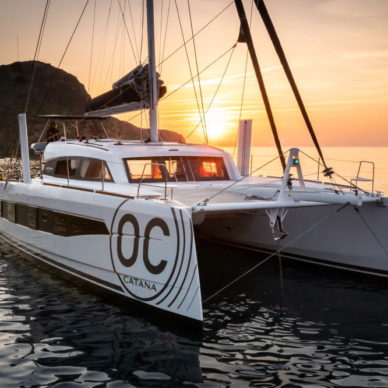
Catana Ocean Class
-
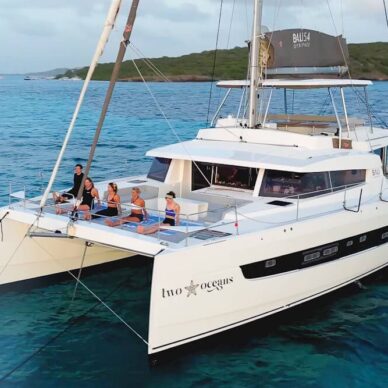
Bali 5.4 For Charter
-
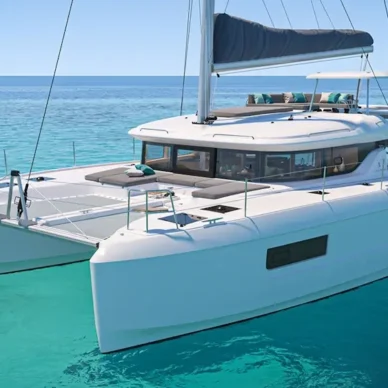
Lagoon 43
-
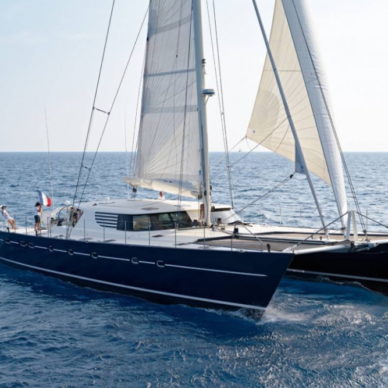
Azizam
-
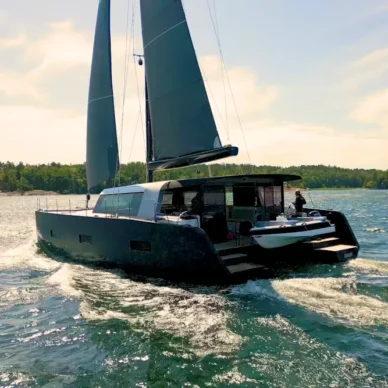
Vaan R5
-
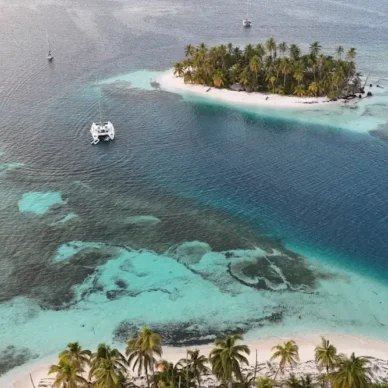
Catamaran Adventures San Blas
-
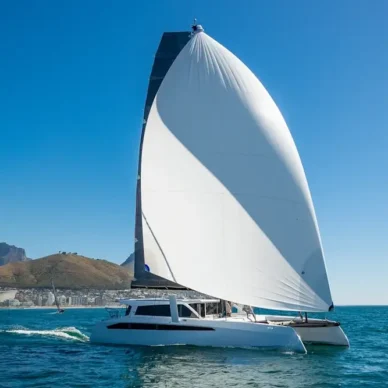
Ocean Renegade R6
-
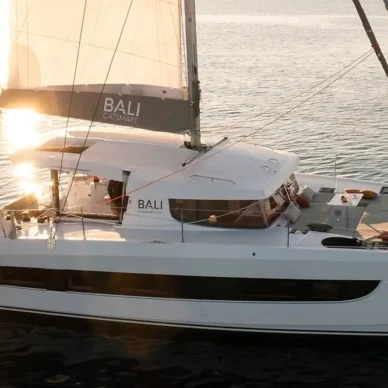
Bali Catsmart 38
Showing 1–8 of 120 results
